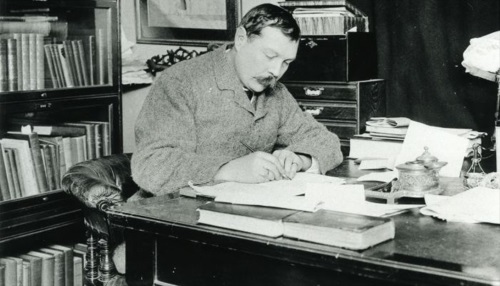
- Investigate
Investigate the Conan Doyle Collection
- Arthur Conan Doyle
Arthur Conan Doyle
- Sherlock Holmes
Sherlock Holmes
- Exhibitions
Exhibitions
- Our Work
Our Work
My Planner
To build your own Itinerary, click  to add an item to your Itinerary basket.
to add an item to your Itinerary basket.
Already saved an Itinerary?

- Investigate
- Arthur Conan Doyle
- Sherlock Holmes
- Exhibitions
- Our Work
- The Detectives
- Illusions of Mystery
- Exhibitions With The Detectives
- Summer of Sherlock Make and Take 2022
- Summer of Sherlock Theatre 2022
- Summer of Sherlock Make and Take 2023
- Summer of Sherlock Theatre 2023
- Letters from the Archive
- Sherlock's Shadow
- Worldwide Doyle Talks 2022-2023
- Worldwide Doyle Workshops 2022-2023
- Open Art Exhibition 2023
- Open Art Exhibition 2023 Immersive Art Experience
- Open Art Exhibition 2023 All Artwork
- Shop
- Support us
- Visit
- You Don't Know Sherlock Holmes, Yet...
- The Portsmouth Connection
- Conan Doyle's life
- Conan Doyle's writings
- Cabinet of Curiosities
- Sherlock memorabillia
- BBC Sherlock Scripts
- Posters
- 23 paces to Baker Street
- Hound of the Baskervilles
- Pursuit to Algiers
- Hound of the Baskervilles by Cook and Moore
- The Scarlet Claw
- Sherlock Holmes faces death
- The Adventures of Sherlock Holmes
- A Study in Terror
- Sherlock Holmes Le Collier de la Mort
- The Secret of Sherlock Holmes
- Granada Studios tour
- La Vie Privee de Sherlock Holmes
- Sherlock Holmes sieht de tod ins Gesicht
- Il Fratello Pui Furbo di Sherlock Holmes
- Baskervilles Hund
- L’ultima avventura di Sherlock Holmes
- Muertre par Decret
- Young Sherlock Holmes
- Sherlock Holmes' Grosster Fall
- MAD magazine
- Sherlock Holmes again
- Strand magazine poster
- MystFest '87
- The Best Sherlock Holmes adventure
- Memorias intimas de Sherlock Holmes
- Sherlock Holmes exhibition
- Les Quincailliers de la Franco Midland
- Leukerbad meeting in Switzerland
- National Children's Dental Health Month
- Sherlock's Last Case
- The Speckled Band
- Sherlock Holmes play
- Sherlock Holmes painting
- Sherlock Holmes Rathbone play
- The many faces of Sherlock
- The Strand Magazine
- Sidney Paget illustrator
- Sherlock Holmes Fandom
You are here: Arthur Conan Doyle

Arthur Conan Doyle was born in Edinburgh on May 22nd 1859. He described his early years as ‘happy,’ spending his days acting out historical adventures and battles, or endlessly pestering his mother and father with questions about science, history, and books.
From the age of 9 he was educated at Stonyhurst, an austere Jesuit boarding school in the north of England, where the familiar public-school curriculum of algebra and classics was enforced through harsh discipline. Conan Doyle, it is said, was disciplined more than most because of his outspoken nature and hot temper.
At Stonyhurst, Conan Doyle was an enthusiastic sportsman, excelling at cricket in particular. He also discovered an ability to write and tell extravagant stories, which his uncle, Richard, encouraged by taking the young Arthur to see plays in London, including Hamlet, featuring Henry Irving, the greatest and most famous actor of the age.
University Life
After leaving school, Conan Doyle trained as a doctor at the University of Edinburgh from 1876 to 1881, during which time his fellow students included J. M. Barrie (who later wrote Peter Pan) and Robert Louis Stevenson, author of Treasure Island and Dr Jeckyll and Mr Hyde.
He also became friends with Dr Joseph Bell, one of the university tutors, a man well-known for his method of deducing information about people and their lives through simple acts of observation and deduction. This was the detective method Conan Doyle later attributed to his great detective, Sherlock Holmes, as he himself later acknowledged, "It is no wonder that after the study of such a character, I used and amplified his methods when…I tried to build up a scientific detective who solves cases on his own merits and not through the folly of the criminal."
Career
Conan Doyle's life illustrates the excitement and diversity of the Victorian period as much as that of any other figure of this period. He was: a surgeon on a whaling ship; a GP; an apprentice eye-surgeon; an unsuccessful parliamentary candidate (twice); a multi-talented sportsman; behind the development of recreational skiing in Switzerland; a formidable public speaker; a campaigner against miscarriages of justice; and the head of an extraordinary family. In his autobiography, he wrote: "I have had a life which, for variety and romance, could, I think, hardly be exceeded." He was not far wrong.
Conan Doyle was a Victorian in so many ways: he was fascinated by travel, exploration, invention, and all things modern, with conventional values such as chivalry, duty, and honour. By the time of his death in July 1930, he had himself become a celebrity, achieving worldwide fame and notoriety through the popular newspapers, photography, and film – media which had all developed during the Victorian period.
Conan Doyle’s career illustrated how Victorian he was. With the Brigadier Gerard series, Professor Challenger fictions, and historical novels such as Sir Nigel, illustrating nineteenth-century interests in the Napoleonic Wars, evolution, science, and the future, as well as the medieval past and national history. Conan Doyle’s relationships with other writers of his time showed just how much he was part of the Victorian, and Edwardian literary scenes:
- He was close friends with, J. M. Barrie, with whom he wrote an operetta
- He was a friend and confidante of George Meredith, the great Victorian novelist
- He formed a society to campaign for a change in the divorce law with Thomas Hardy, author of Tess of the d’Urbervilles and The Mayor of Casterbridge
- He holidayed with H. G. Wells (another one-time resident of Southsea and the author of The Time Machine and War of the Worlds) in Italy in 1898
- He shared Thanksgiving in Vermont in 1894 with Rudyard Kipling, during which time he taught Kipling to play golf
As his work with Thomas Hardy illustrated, Conan Doyle was also a campaigning figure: fighting for changes in the ways in which the army fought and operated, as well as successfully helping in the release of two prisoners convicted of crimes they did not commit, George Edalji and Oscar Slater.
Read more about Conan Doyle's Fight for Justice
Books
The first story Arthur Conan Doyle wrote about Holmes, an 1887 novel called A Study ín Scarlet, appeared in Beeton's Christmas Annual. In a sense, literature's most famous detective was born on that day.
Another entry in the Holmes canon, The Adventure of the Blue Carbuncle, ís a Christmas tale that Doyle's devotees often cite as a personal favoríte.
Later, when Doyle tired of Holmes, he killed off his character during the yuletide. In The Final Problem, the fatal encounter between Holmes and his archnemesis, Moriarty, takes place in the spring, but the story itself appeared in the December 1893 issue of The Strand Magazine.
Such was the uproar from Sherlock Holmes' fans, Conan Doyle was later persuaded to resurrect the detective and create further stories to meet the public's demand.
Inspiration
- Arthur Conan Doyle was the eldest of son of noe siblings, seven of whom survived into adulthood. He had five children from his two marriages.
- Apart from Sherlock Holmes perhaps the most significant aspect of Conan Doyle’s later life was his conversion to the cause of spiritualism.
- Throughout his career Conan Doyle made much of his commitment to truth over untruth, justice over injustice. This was much in evidence in his campaigning work on behalf of victims of miscarriages of justice, such as George Edalji and Oscar Slater.
- The Collection contains all of Conan Doyle’s works, including first and early editions in many languages, derivative fiction, bound volumes and single issues of journals.
- Sherlock Holmes, created by Sir Arthur Conan Doyle, perhaps the most famous detective of them all
- A wide ranging exhibition featuring items and documents from the Collection. This exhibition covers Conan Doyle's life and works, including his arrival in Portsmouth, his books, his fights for justice and the phenomena that is Sherlock Holmes.
© Conan Doyle Collection 2025. All Rights Reserved







